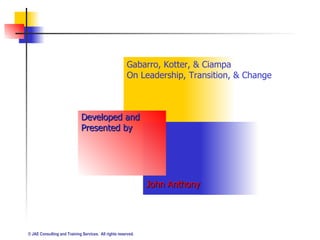Gabarro, Kotter, and Ciampa On Leadership, Transition, and Change
•
1 like•1,621 views
Report
Share
Report
Share

Recommended
Recommended
More Related Content
What's hot
What's hot (20)
Organizational Change and Development - Module 1 - MG University - Organizat...

Organizational Change and Development - Module 1 - MG University - Organizat...
Change Management - How to manage change in your organization successfully. A...

Change Management - How to manage change in your organization successfully. A...
Viewers also liked
Viewers also liked (8)
Similar to Gabarro, Kotter, and Ciampa On Leadership, Transition, and Change
Managing Change, Change Management Process, Types of Change and Challenges in Change ManagementManaging change, change process, change types and challenges in change manage...

Managing change, change process, change types and challenges in change manage...Al - Qurmoshi Institute of Business Management, Hyderabad
Similar to Gabarro, Kotter, and Ciampa On Leadership, Transition, and Change (20)
Why Do We Need Strong Change Management in the Way We Look at Remote Work Pol...

Why Do We Need Strong Change Management in the Way We Look at Remote Work Pol...
Managing change, change process, change types and challenges in change manage...

Managing change, change process, change types and challenges in change manage...
NCV 4 Management Practice Hands-On Support Slide Show - Module 5

NCV 4 Management Practice Hands-On Support Slide Show - Module 5
HBRs 10 Must Reads on Change Management The Hard Side of Change .docx

HBRs 10 Must Reads on Change Management The Hard Side of Change .docx
6 Change Management StagesA Management Checklist to Guide Your E.docx

6 Change Management StagesA Management Checklist to Guide Your E.docx
6 Change Management StagesA Management Checklist to Guide Your E.docx

6 Change Management StagesA Management Checklist to Guide Your E.docx
Organizational Change Management PaperContentsYour paper.docx

Organizational Change Management PaperContentsYour paper.docx
Gabarro, Kotter, and Ciampa On Leadership, Transition, and Change
- 1. Gabarro, Kotter, & Ciampa On Leadership, Transition, & Change Developed and Presented by John Anthony
- 21. Developed and Presented by John Anthony Gabarro, Kotter, & Ciampa On Leadership, Transition, & Change